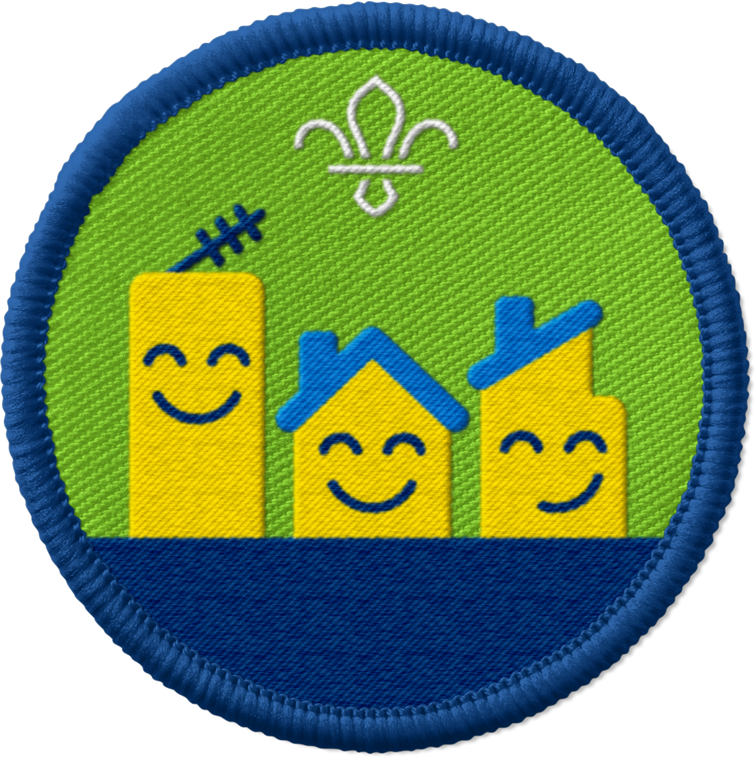
What makes a house a home?
You’ll need
- Natural materials (for example, leaves, twigs, feathers)
Before you begin
- If you don’t have any natural materials like twigs or leaves, you could collect some objects from around your meeting space to use instead like bean bags, balls, cones, or other markers.
- This activity involves reading the story Still a Family by Brenda Reeves Sturgis. Make sure you save a copy of the story before the session.
Story time
- Everyone should sit in a circle. Someone should read Still a Family by Brenda Reeves Sturgis.
- Once everyone’s heard the story, they should take some time to reflect on it as a group. We’ve added some ideas in the pink box below to help.
What makes a house a home?
- Everyone should split into smaller groups.
- Each group should spend a few minutes collecting some natural materials like twigs or leaves to use for the activity.
- Everyone should use the things they’ve collected to make a picture of a house.
People only need to make an outline – they could think about the shape of the building and roof, as well as any other features they want to add.
- Everyone should look at their house shape and think about what makes their house a home. The person leading the activity should explain that a house is just a building – a place might feel like a home because of special belongings, people who also live there, or activities they do.
Remind everyone about the story you read at the start of the session. The family didn’t have a house, but they were still a family – they still celebrated together, eat meals and played games.
- Everyone should take it in turns to share one thing that makes their house a home with the rest of their group. Once they’ve shared their idea, they should add something to the middle of the house they created. For example, everyone could use some of the things they collected to make some people who live in their house.
You could print off some pictures, everyone could bring an item along with them, or people could write or draw on some scrap paper.
- Each group should share their homes with everyone else. What things did they include to make the house a home?
- To finish, the person leading the activity should explain that everyone’s home is different.
- Everyone should chat about how they can learn more and help to make sure that everyone has a place they can call home.
Actions you can take
Share the message
Everyone could share what they made when you get home. What do the people they live with think? What makes their house a home?
Kettle cooking
You could try Kettle cooking and chat about making meals in difficult circumstances.
Try some fundraising
You could fundraise for Crisis or Simon Community NI. Why not work with your group to see how much you can raise together?
Reflection
This activity was all about caring and respecting others. It’s designed to help people start to explore how we think about our homes and the issue of homelessness.
Read the story
- The people in the story didn’t have a house, but they were still a family. Think about the activities they did together like playing in the park and playing hide and seek. Does anyone enjoy doing any of the same things?
- Can the group think of some other things that they enjoy doing with the people they live with?
What makes a house a home?
- Look at the pictures the groups made. Was everyone’s house the same? What things looked different?
- What kind of things did everyone add to make their house a home? Did anyone put the same things in their house?
- Ask everyone to think about what is most important – is it the things they have, or the things they do together?
Safety
All activities must be safely managed. You must complete a thorough risk assessment and take appropriate steps to reduce risk. Use the safety checklist to help you plan and risk assess your activity. Always get approval for the activity, and have suitable supervision and an InTouch process.
- For more of a challenge, you could try only using natural materials that you can find outside.
- You could try making a 3D model together.
- For a simpler activity, try working as one big group to make one picture together.
- Make sure everyone can get involved. You could prepare some items or pictures to use in the second part of the activity to help everyone think of ideas.
- Discussing homelessness may be difficult for young people who have experienced homelessness or have connections to it through other people. Make sure they know you’ll be covering the topic, and check what you can do to make it easier. This may involve avoiding specific scenarios or making sure there’s a space for them to take a break. Make sure people’s communication is respectful and supportive.
All Scout activities should be inclusive and accessible.
Check out some of the actions above and challenge everyone to do something to help make a difference. Think about setting everyone a challenge to complete at home before your next session.
